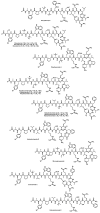"Head-to-side-chain" cyclodepsipeptides of marine origin
- PMID: 23697952
- PMCID: PMC3707169
- DOI: 10.3390/md11051693
"Head-to-side-chain" cyclodepsipeptides of marine origin
Abstract
Since the late 1980s, a large number of depsipeptides that contain a new topography, referred to as "head-to-side-chain" cyclodepsipeptides, have been isolated and characterized. These peptides present a unique structural arrangement that comprises a macrocyclic region closed through an ester bond between the C-terminus and a β-hydroxyl group, and terminated with a polyketide moiety or a more simple branched aliphatic acid. This structural pattern, the presence of unique and complex residues, and relevant bioactivity are the main features shared by all the members of this new class of depsipeptides, which are reviewed herein.
Figures













Similar articles
-
Marine Depsipeptides as Promising Pharmacotherapeutic Agents.Curr Protein Pept Sci. 2017;18(1):72-91. doi: 10.2174/1389203717666160526122130. Curr Protein Pept Sci. 2017. PMID: 27226199 Review.
-
Bioactive peptides and depsipeptides with anticancer potential: sources from marine animals.Mar Drugs. 2012 May;10(5):963-986. doi: 10.3390/md10050963. Epub 2012 Apr 26. Mar Drugs. 2012. PMID: 22822350 Free PMC article. Review.
-
Synthesis and Biological Activities of Cyclodepsipeptides of Aurilide Family from Marine Origin.Mar Drugs. 2021 Jan 23;19(2):55. doi: 10.3390/md19020055. Mar Drugs. 2021. PMID: 33498789 Free PMC article. Review.
-
Mollemycin A: an antimalarial and antibacterial glyco-hexadepsipeptide-polyketide from an Australian marine-derived Streptomyces sp. (CMB-M0244).Org Lett. 2014 Mar 21;16(6):1716-9. doi: 10.1021/ol5003913. Epub 2014 Mar 11. Org Lett. 2014. PMID: 24611932
-
Asymmetric Synthesis of the C15⁻C32 Fragment of Alotamide and Determination of the Relative Stereochemistry.Mar Drugs. 2018 Oct 30;16(11):414. doi: 10.3390/md16110414. Mar Drugs. 2018. PMID: 30380702 Free PMC article.
Cited by
-
Synthesis of complex head-to-side-chain cyclodepsipeptides.Nat Protoc. 2016 Oct;11(10):1924-1947. doi: 10.1038/nprot.2016.116. Epub 2016 Sep 15. Nat Protoc. 2016. PMID: 27658010
-
Therapeutic peptides: current applications and future directions.Signal Transduct Target Ther. 2022 Feb 14;7(1):48. doi: 10.1038/s41392-022-00904-4. Signal Transduct Target Ther. 2022. PMID: 35165272 Free PMC article. Review.
-
Tutuilamides A-C: Vinyl-Chloride-Containing Cyclodepsipeptides from Marine Cyanobacteria with Potent Elastase Inhibitory Properties.ACS Chem Biol. 2020 Mar 20;15(3):751-757. doi: 10.1021/acschembio.9b00992. Epub 2020 Jan 28. ACS Chem Biol. 2020. PMID: 31935054 Free PMC article.
-
Virtual Screening of Marine Natural Compounds by Means of Chemoinformatics and CDFT-Based Computational Peptidology.Mar Drugs. 2020 Sep 20;18(9):478. doi: 10.3390/md18090478. Mar Drugs. 2020. PMID: 32962305 Free PMC article.
-
Chemical Reactivity Properties, pKa Values, AGEs Inhibitor Abilities and Bioactivity Scores of the Mirabamides A⁻H Peptides of Marine Origin Studied by Means of Conceptual DFT.Mar Drugs. 2018 Aug 28;16(9):302. doi: 10.3390/md16090302. Mar Drugs. 2018. PMID: 30154377 Free PMC article.
References
Publication types
MeSH terms
Substances
LinkOut - more resources
Full Text Sources
Other Literature Sources

